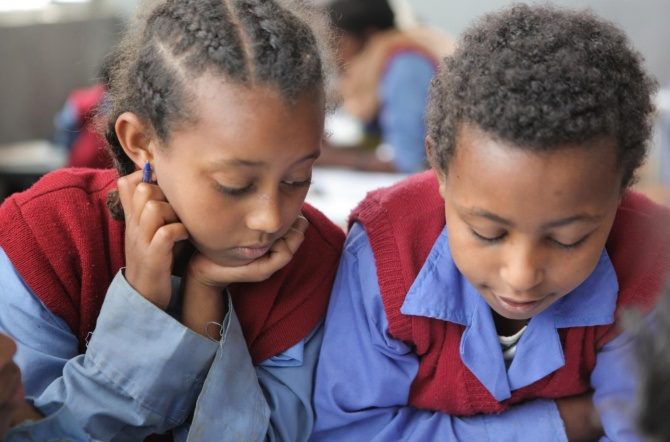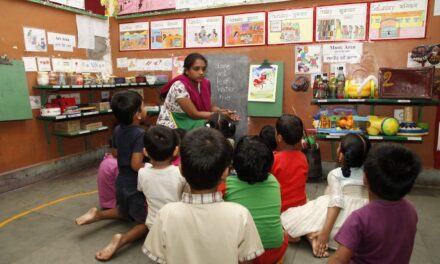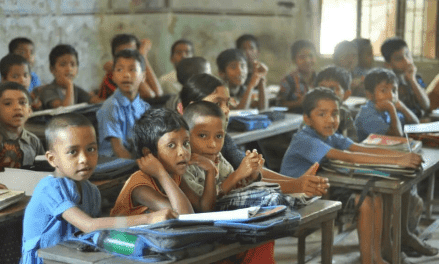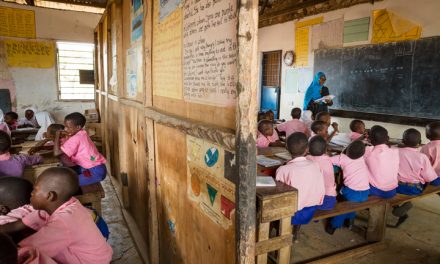By Don Taylor, UKFIET Executive Committee
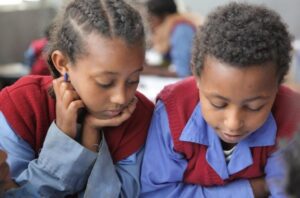
A girl and her classmate read.
Hidassie School, Addis Ababa, Ethiopia, November 2013.
Picture: GPE/Midastouch.
DFID has just released a new Education Policy paper, entitled Get Children Learning. It sets out DFID’s current priorities in education and its vision for change in the future. It is a hugely ambitious agenda, full of good intentions and ‘we will ….’ commitments. In seeking to tackle the global learning crisis, DFID ‘will focus on three priorities’:
- Invest in good teaching, as the most critical factor affecting learning in schools
- Back system reform which delivers results in the classroom
- Step up targeted support to the most marginalised (children with disabilities, children affected by conflict and crisis, and hard-to-reach girls).
The ‘vision for change’ includes commitments for DFID to hold itself, as well as other governments and partners, accountable for improving the quality of teaching and learning. Nowhere is there a timeframe in the document to indicate when all the commitments will be fulfilled. Nor is there any promise to increase allocations of UK aid to education, either in amount or as a share of total UK aid. In this respect, the new policy paper is not a direct response to the International Development Committee (IDC)’s report – DFID’s work on education: Leaving No one behind? published in November 2017. This new paper was commissioned by the then Secretary of State, Priti Patel, much earlier last year. It has been many months in gestation within DFID, and subject to limited external consultation in draft form.
The new policy does respond more directly to the call from the IDC for a strong focus on the most marginalised children, including refugees and displaced children. It includes a very ambitious commitment to ensure that hard-to-reach girls learn the basics and progress through 12 years of quality education and learning.
The analysis underlying these new policy priorities is presented in a section on ‘the case for action’, drawing on recent experience and research evidence, with a very extensive set of references. DFID’s approach is described as one of ‘tackling the learning crisis at its root’ through a strong focus on the training, motivation and performance of teachers in primary and junior secondary schools, to ensure that children acquire basic foundational skills.
There are two brief references to Sustainable Development Goal (SDG) 4 in the document but no mention of climate change or environmental sustainability, or even of science in the secondary school curriculum. Nor is there any mention of the unfinished business from the Millennium Development Goals (MDGs) – some countries still have a long way to go before achieving universal access and enrolment in primary education and gender parity at all levels.
Each of the three main priorities is elaborated in a separate section, and the paper ends with a section on Britain’s role on the world stage. This boldly claims that the UK ‘leads the world on international development’ and that ‘DFID will take on global leadership on education for children with disabilities’. One paragraph calls for more and better spending on education by national governments and international partners, and for an increased share of donor funding to be allocated to education, without any such commitment on the part of DFID itself or the UK government. There is surprisingly little emphasis on Value for Money in education, given DFID’s emphasis on this issue since 2010.
DFID wants to help national governments to reform their education systems, including the systems for recruitment, training, deployment, and management of teachers. It wants to strengthen tax systems to increase domestic investment in education and to challenge the disproportionate amount spent on higher education in many countries. Whether DFID has the authority and capacity to deliver such reforms, however laudable they would be, must be doubted and remains to be seen.
The new policy document does acknowledge that when and where there is no national leadership to turn things round, then DFID will ‘look beyond stagnant public sectors’ and seek to invest ‘through alternative channels’, including ‘non-state providers’. But this is not a blanket endorsement of private schools and there is also recognition of the need for strong regulatory and accountability mechanisms.
There are very few references to particular countries in the new policy, apart from examples in text boxes, but the distribution of UK aid for education ‘by benefiting country’ over recent years is shown on a map as an Annex to the document. This reveals that 34 countries have received DFID funding for education, suggesting that such spending is now more widely and more thinly spread than it was in the past, but perhaps more highly targeted to fragile states and priority groups of children.
The outcome of the DFID education ‘policy refresh’ is reflected in this new document. It replaces the Education position paper: improving learning, expanding oportunities of 2013 which itself stated that it stopped short of being ‘a full education strategy’ and did ‘not contain new policy’. The new 2018 paper is a more comprehensive and formal statement of DFID Education Policy. Its release on 2 February was timed to coincide with the replenishment conference of the Global Partnership for Education (GPE) last week, at which the UK pledged to increase support for education in partner countries through the GPE.

